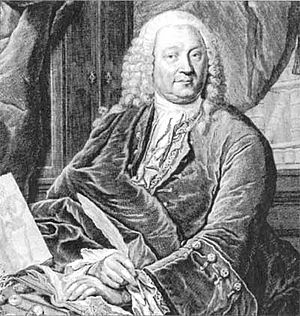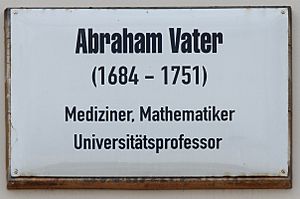Abraham Vater facts for kids
Quick facts for kids
Abraham Vater
|
|
|---|---|
 |
|
| Born | 9 December 1684 Wittenberg, Germany
|
| Died | 18 November 1751 (aged 66) |
| Nationality | German |
| Alma mater | University of Wittenberg |
| Known for | First to describe hepatopancreatic ampulla |
| Scientific career | |
| Fields | Anatomy |
Abraham Vater (born December 9, 1684 – died November 18, 1751) was a German anatomist from Wittenberg. An anatomist is a scientist who studies the structure of living things.
Vater was a very smart student. He earned his first university degree, called a doctorate in philosophy, from the University of Wittenberg in 1706. Later, in 1710, he received his medical degree from the University of Leipzig. After finishing his studies, he traveled around Germany, Holland, and England to learn more about science and medicine. In Amsterdam, he met another famous scientist named Frederik Ruysch.
When he returned to Wittenberg, Vater became a professor at the university. He started as an associate professor in 1719, then became a full professor of anatomy in 1732. Later, in 1746, he also became a professor of therapy, which is about treating illnesses.
What Was Abraham Vater Known For?
Abraham Vater is best known for his important discoveries in anatomy. He was the first person to describe a special part of the body called the hepatopancreatic ampulla. This is a small meeting point where two important tubes, the pancreatic duct and the common bile duct, join together. These tubes carry liquids that help your body digest food. Today, this part of the body is often called the ampulla of Vater in his honor.
In 1719, Vater also made another interesting discovery. He found tiny, oval-shaped organs in the skin that were wrapped around nerve endings. These organs were very small, only about 1 to 4 millimeters long. He called them papillae nervae.
For a while, his research on these tiny organs was forgotten. But in 1831, another anatomist named Filippo Pacini rediscovered them while studying a hand. Pacini was the first to figure out what these organs actually did. He discovered they were mechanoreceptors, which means they are special sensors that feel things like vibrations and changes in pressure.
Because of Pacini's work, these organs became known as Pacinian corpuscles. However, to give credit to both scientists, they are sometimes called "Vater-Pacini corpuscles" today. These are just one type of sensor in your body. Other similar sensors include Meissner corpuscles (for touch), Ruffini corpuscles (for skin stretching), and Krause corpuscles.
Vater's name is also connected to something called "Vaters fold." This is a small fold in the lining of the duodenum, which is the first part of your small intestine. This fold is located just above the ampulla of Vater.
See also
 In Spanish: Abraham Vater para niños
In Spanish: Abraham Vater para niños
- German inventors and discoverers


